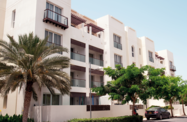Oman’s real estate sector is slowly regaining momentum after more than a year of reduced activity. The increase in demand is being seen in a number of sectors whilst oversupply in others has resulted in weaker take-up, although this could soon be overcome as the impact of a massive government investment programme starts to be felt more acutely.
The government is planning to spend $78bn over the coming five years in a series of investment programmes aimed in part at reducing dependence on hydrocarbons by building up other industries and expanding infrastructure, while also bolstering social services and support for the private sector. The investment package is expected to have a significant impact on the country’s real estate sector by increasing both demand and private spending power.
According to the results of Oman’s latest census, released in late December, the population stands at just under 2.7m, of which 1.95m are Omani nationals and 742,000 are expatriates. The census showed that there had been steady progress in meeting housing needs, with a total of 546,000 housing units in existence as of the end of 2010, well up on the 431,000 of 2003, the last time a national census was conducted.
With the new five-year development plan, demand for housing is forecast to increase, especially as the number of foreign professionals employed in the Sultanate is expected to rise. Coupled with the higher rate of domestic employment and stronger spending power for Omani nationals, this demand could further stimulate the residential segment of the sector.
Matthew Wright, a strategic consultant at international property consultants Cluttons, told local press in January that the high levels of investment in infrastructure will directly lead to an increase in real estate activity in the industrial sector, but that the broader effects will flow throughout the market.
The fillip will be very welcome, with the residential and commercial components of the property market still well off the peaks of two years ago, according to a report from Cluttons. Issued in early January, the report said that while there had been an improvement in sales and prices in some categories, continued oversupply in the commercial segment and slow demand for high-end residential properties – especially those in integrated tourism complexes – indicate that the market could remain weak for some time yet. “Cluttons does not feel that the bottom of the market has been reached, and foresees a continued softening of secondary market values over Q1 2011,” said the report.
With an estimated 500,000 sq metres of new office space set to come onto the market by the end of 2013, the price of commercial property was likely to ease back, the report said, while rents in this segment are likely to decline. To counter this, commercial property owners needed to take steps to ensure they hold onto existing tenants and attract new ones. “It is vital that landlords adopt a proactive approach, with the emphasis being on achieving and maintaining good occupancy rates rather than concentrating on high headline rental values,” the report noted.
It is likely that this oversupply of commercial properties will be a medium-term problem, with the heightened economic activity expected over the next few years – a result of the government’s development package – helping to reduce the existing supply of business space and boost rent returns.
It is also possible that the state’s investment programme could push up real estate prices in the coming years. The scale of the projected increase in construction activity may put pressure on materials supplies, potentially driving up building costs as a result. This inflation could, in turn, then be passed on to new property buyers.
Despite this possibility, the real estate sector is in line to maintain its steady recovery over the next few years. With Oman’s GDP forecast to increase by around 6% annually over the term of the latest five-year plan and thousands of new jobs set to be created, more Omanis will be in a position to buy a home of their own, fuelling demand and fulfilling the government’s objective of boosting private equity in the economy.

